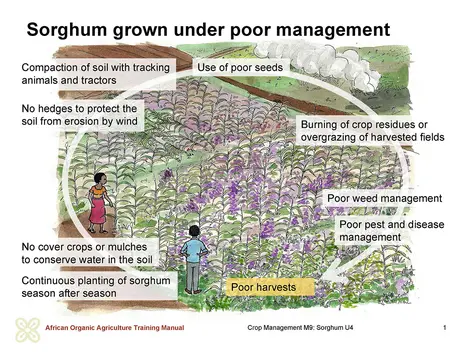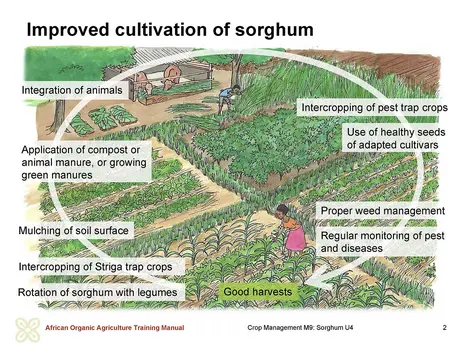Introduction and challenges
Sorghum (Sorghum bicolor) is an important cereal for food (mainly for subsistence) and fodder in tropical, semi-arid Africa. It is mainly grown in Sudan, Nigeria, Burkina Faso, Ethiopia, Mali and Egypt, but also in other African countries and contributes to the food security of the most food-insecure agro-ecological zones. The grains have also become an important feed for livestock, especially for pigs and poultry, due to an increasing demand for meat and dairy products. It is considered one of the best crops for silage to feed livestock, because of the high yields, high sugar content and the juiciness of the stalks. However, green sorghum grain and forage are not suitable for pasture, because they contain substances that are poisonous to livestock. Basically, there are five races of cultivated sorghum, namely bicolor, guinea, caudatum, durra, and kafir, each with specific characteristics. Besides being grown for grain and fodder, specific sorghum types are grown as a raw material for industrial processes such as syrup, sugar, beer and fibre production or textile dyeing. In some countries the stems of sweet sorghum types are chewed like sugar cane and are sold along roadsides and on markets at rural development centres. Sorghum is a vigorous, hardy and drought-tolerant crop, which grows up to 4 metres tall and has a high potential yield. It is a perennial grass, but is mostly cultivated as an annual crop. Sorghum has the ability to go into dormancy during drought conditions and to resume growth when the rains come, because it has a more efficient root system than most cereal crops (with the exception of millet) and rolls its leaves to reduce evapotranspiration. Sorghum does well in hot climates that are too dry for maize. For early maturing cultivars 500 to 800 mm of rain are normally adequate, if they are evenly distributed over the cropping season. In some areas sorghum has been replaced by maize because it yields better under favourable conditions, is less liable to bird damage and easier to process. In less favourable environments this has repeatedly resulted in severe crop losses when drought occurred. Therefore, in hot and dry climates of Africa sorghum will remain an important food security crop. In the tropics sorghum can be grown at altitudes up to 2300 m, but temperatures below 12–15 °C during flowering may result in sterility. Still, sorghum is less susceptible to frost than maize. Although sorghum grows well on a wide range of soils, the best results are achieved on loams and sandy loams. Sorghum is adapted to poor soils and can produce grain on soils where many other crops would fail. In some areas of Africa with soils with high water content sorghum is sown in the early dry season and grows with residual moisture only.
Challenges to sorghum production in Africa
Sorghum yields are generally low in Africa, ranging from 500 to 600 kg per hectare, which is far below the potential of the crop. The low yields may be attributed to a number of challenges, which include:
- Limited access to good quality seeds: Most sorghum farmers typically grow traditional varieties. In most cases these landraces are well adapted to local conditions and have low nutrient requirements, but are low yielding. This is partly because farmers do not carefully select the sorghum seed, but instead pick seeds randomly from any remaining stock from the previous season.
- Decreasing soil fertility: Most farmers grow sorghum as a mono-crop, season after season, without any added inputs for soil improvement. Due to the continuous loss of nutrients with every harvest, soil fertility continues to decline. In the long run, nutrients become deficient, thus affecting the ultimate sorghum yields. Farmers who use commercial fertilisers also experience declining soil fertility if they do not manage soil fertility sustainably.
- Pest and disease problems: Many pests and diseases are known to attack cultivated sorghum while others can cause considerable losses during storage. The main insect pests of sorghum include the shoot fly, stemborers, sorghum midge and head bugs. In the traditional farming context in Africa, direct control measures are rarely undertaken, as the crop is mostly cultivated under low input conditions. In situations where sorghum is grown continuously on the same fields without rotation, the risk of pests and diseases increases, especially where diseases like anthracnose, leaf blight, leaf spot and tar spot, downy mildew or rusts are prevalent. Other diseases include the honeydew disease or ergot, root and stalk rots. In many parts of Africa, birds are also common pests of ripening sorghum causing enormous losses before it is harvested.
- Water problems: Due to its drought tolerance, most farmers in sub-Saharan Africa rely solely on rainfall during the entire growing period. However, prolonged drought favours pest attack by bugs and mites and delays maturity. Therefore, water conservation and, where possible, the additional supply of water through irrigation increases the yield potential of the crop.
- Weed problems: Weeds are a big constraint to sorghum production, especially during periods with favourable growing conditions. When water is available, weeds can multiply very fast and outgrow the sorghum plants, if the farmer does not intervene in time. They will compete for space, nutrients and water, hence reducing the eventual yields obtained. Specifically, the parasitic Striga weed (Striga hermontica) causes significant yield losses in sorghum production and is widespread in Africa.
Organic production practices, which emphasise the sustainable utilisation of soil resources as well as other good agricultural practices, can improve sorghum yields in Africa. In some countries success has been achieved by using improved varieties and by improving soil fertility and water management. Therefore, this chapter discusses the importance of these strategies as well as other organic production practices to increase sorghum productivity and yields.
Discussion: Assessment of local sorghum production
Inquire about the status of sorghum production in the area, using the following questions:
- How important is sorghum in the area? What are its uses?
- How is sorghum commonly grown? Which other crops are commonly grown with sorghum? What are the average yields?
Discussion: Local challenges facing sorghum production
Engage the farmers in a brainstorming session to highlight the key challenges to sorghum production under the local pro-duction situation. Find out whether the farmers have experienced any of the above or any other challenges and how they have tried to address them.


 tap and then scroll down to the Add to Home Screen command.
tap and then scroll down to the Add to Home Screen command.